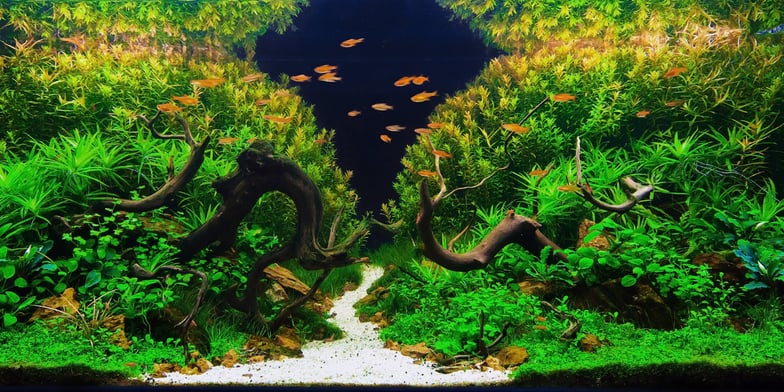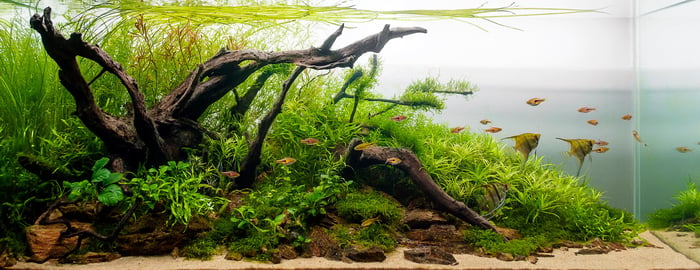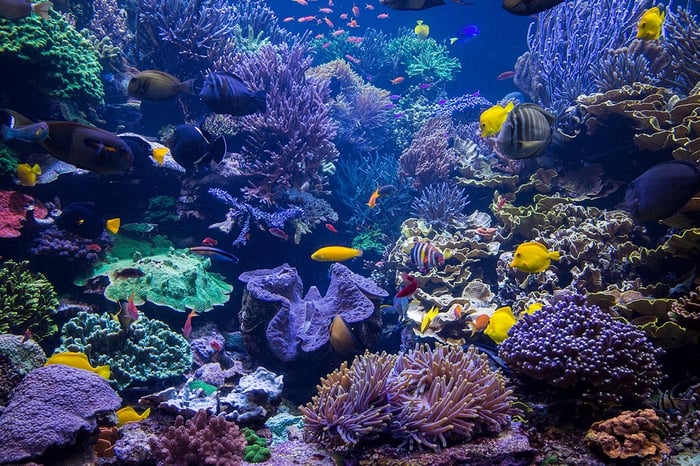 The natural world is widely used as a source of inspiration for countless works of art. Some of the world’s most well-known artworks illustrate nature to convey the artist’s message. Art can manifest itself in a variety of forms, some more conventional than others.
The natural world is widely used as a source of inspiration for countless works of art. Some of the world’s most well-known artworks illustrate nature to convey the artist’s message. Art can manifest itself in a variety of forms, some more conventional than others.
One form that is not commonly thought of are aquariums. Although not all aquariums can be considered art, many styles of aquariums utilize natural elements from the real world. These aquatic landscapes can mimic the coral reefs of tropical oceans or underwater freshwater jungles.
The practice of creating realistic nature aquariums is known as aquascaping. Not only does aquascaping utilize nature and artistic composition but also science, biology, and water chemistry. This profound relationship between nature, artistic design, and science mesh to form beautiful aquatic landscapes perfect for any home.
What is an Aquarium?
Aquariums are artificial aquatic habitats containing a variety of fish, plants, coral invertebrates, or other water-dwelling organisms that come in a variety of shapes, sizes, types, and styles.
The two broad categories consist of freshwater and saltwater aquariums, the latter housing marine animals which often mimic ocean environments. Both freshwater and saltwater aquariums also have sub categories based on the types of livestock that are kept.
The more artistic types of aquariums utilize natural elements to create an aquatic landscape. Lacking artificial decor, these nature aquariums look to our environment for sources of inspiration. Whether that be an underwater Amazonian jungle, ornate Japanese “Iwagumi style” rock formations, or a tropical coral reef, owning a living work of art in your home has never been easier or more exciting.
Aquascaping
Aquascaping is the practice of creating a natural aquatic landscape in your aquarium. It’s commonly associated with freshwater live planted aquariums, however saltwater reef aquariums also utilize this practice.
Reef aquariums use rock to create structures in which live coral is attached or placed. The placement of many corals is crucial for most species. This is because different types of coral have different requirements in terms of flow, light intensity, or proximity to other coral. Corals requiring higher light are often placed in elevated positions, which coral species require lower lighting are often placed further down in the aquarium closer to the bottom.
Similarly, certain corals require specific amounts of water flow or current. Corals that require more flow are placed closer to pump outputs, powerheads, or wavemakers. Oppositely, corals requiring less flow are placed further away from current sources, and can be sheltered by rocks.
In freshwater, live aquatic plants are often the focus of these aquariums but natural elements, such as rocks or driftwood, are used to create a hardscape. Many distinct styles of freshwater aquascapes exist, such as the heavily planted Dutch style aquascape or Japanese-inspired nature displays. Some freshwater aquascapes have no plants and solely utilize decorative driftwood, stones, or other hardscaping materials.
Not only do various aquascapes provide living artwork to your home, they also provide a more realistic habitat for your fish which can reduce stress. In reef aquariums, there are numerous species of fish which require a reef tank environment in order to properly thrive.
Many species of fish and other aquarium species prefer places to hide or burrow. The aquascape of a reef or planted aquarium becomes pivotal in providing certain species of aquaria inhabitants with specific housing requirements. Recreating a natural habitat in your home aquarium can be both an educational and a stunning addition to your home.
Planted Tanks
Planted tanks or planted aquariums are one of the most popular types of home aquascapes. This type of aquarium houses freshwater species of fish with an emphasis on full aquatic live plants. These plants grow throughout the aquarium gravel to create a living ecosystem arranged in stunning displays. Plants are pruned and placed to achieve a desired look.
When creating a planted aquarium, adding the substrate is the first step. Often fertilized gravel, sands, or other media are used as a base for plants to spread their roots. These substrate medias are often layered and can change based on the types of aquarium plants or desired look.
Then the hardscape is often laid down next, utilizing driftwood, rocks, or other natural materials to create a realistic display. Depending on the style of your planted aquarium, the hardscape may play a more impactful role in the overall design. Specific plants are chosen based on lighting requirements and arranged in the aquarium depending on their height or growth pattern.
Short plants that tend to spread are often placed upfront in the foreground, while taller plants usually reside in the background. This not only allows for maximum viewing of all plants, but creates depth, resulting in a more realistic appearance.
Reef Aquariums
Saltwater aquariums are generally separated in two categories: reef aquariums and fish-only tanks. Reef aquariums can house various species of live coral, fish, crabs, shrimp, other invertebrates, and live rock arranged in a mini ecosystem, with the emphasis being on coral.
Fish-only saltwater aquariums don’t include live coral and can contain species of fish deemed not “reef safe.” The term reef safe is used to describe fish that are not compatible with coral or invertebrates commonly found in aquariums. Many species of marine fish will eat decorative coral, smaller reef safe fish, beneficial crabs, or snails which can consume nuisance algae. Because of this, these fish are deemed incompatible and unsafe to house in a reef tank.
Fish that are reef safe will not harm coral, crabs, snails, shrimp, or other organisms which can be beneficial for a successful reef tank. In a coral reef aquascape rock is usually stacked to create height and real estate for coral. Aquarium safe putty, dowles, super glue, or other adhesives are used to secure rock formations and attach coral.
Making sure corals are secured is important for healthy growth. Many fish or invertebrates will move coral, which might cause it to fall and potentially hurt the frag or colony. Placement of coral is very important as certain species require more or less light or flow.
In addition, many corals have stinging tentacles that expand. Certain species cannot be placed too close to others as they may use their sweeper tentacles and sting neighboring corals. Knowing the specific requirements of different coral species is a critical component to successful reef tank aquascaping.
The Importance of Lighting and Water Chemistry in Aquariums
It’s often said that owning a successful aquarium is less about keeping fish and more about maintaining proper water quality. Whether you are keeping a five-gallon nano aquarium or working on a 10,000 gallon public display tank, the most important aspect for success is water chemistry.
Although water may appear safe for fish, the only way to know for certain is to test your aquarium water chemistry. This may seem intimidating but aquarium technologies developed to make owning a successful aquarium not only easy but therapeutic and educational.
Planted aquariums and reef tanks share many similarities regarding proper water chemistry, but also have profoundly different requirements. The biggest difference is the significantly greater amounts of dissolved salts in reef tanks compared to planted aquariums.
Seawater tends to have a natural salinity of 35 ppt (parts per thousand), meaning that every kilogram of water has 35 grams of dissolved salts. This corresponds to a specific gravity of 1.0264 @ 20°C and a conductivity of 54 mS/cm. For planted aquariums total dissolved solids is often used to determine the amount of dissolved ions in the water, many of which plants will use for growth.
In planted aquariums, carbon dioxide gas (CO2) is often diffused into the water. CO2 plays a critical role in photosynthesis of plants. Supplementing CO2 into the water column can help increase growth and overall health of aquatic live plants, which makes the tank look better overall. When adding CO2 to your planted aquarium, it’s important to monitor levels with a test kit to prevent overdosing, which could kill your aquarium livestock.
In a saltwater reef aquarium, as corals grow, elements are depleted from the water. In order to maintain adequate water parameter levels for corals, reef tank hobbyists will replenish elements by either water changes, supplementation or various reactors. The most commonly dosed elements include alkalinity, calcium, and magnesium. Dosing schedules will often be automated by use of dosing pumps or calcium reactors. In order to fine tune precise levels, regular water testing is critical for knowing how much supplementation to add.

Other important water parameters to test for in both reef tanks and planted aquariums include ammonia, nitrite, nitrate, phosphate, dissolved oxygen, alkalinity, total dissolved solids, pH, and temperature. Light intensity is also critical for both reef tanks and planted aquariums as many coral species and live plants require light for photosynthesis.
Benefits of Owning an Aquarium
Creating a beautiful natural aquarium not only adds live artwork to your home, but also has other benefits. Spending time observing your aquarium has shown proven therapeutic effects for reducing stress and anxiety[1]. Aquariums are often setup in doctors or dentist office waiting areas to not only for decoration but also to promote a calming mentality, potentially easing nervous patients.
Getting into fish keeping requires knowledge of various species of animals and care requirements. Taking the time to learn about your aquarium can help foster an increased appreciation for the environment and science.
Furthermore, maintaining a beautiful aquascape from the start helps you develops skill and provides meaningful artwork to your home. Often the start of a reef tank or planted aquarium is not the best it will look. To create a more realistic appearance, your coral and plants need time to grow and fill in space. This gives the aquascape a more natural presentation and, if properly maintained, your aquascapes will only look better over time.
Whether you are keeping a reef tank display or an Amazonian-inspired planted aquarium, elements of nature and knowledge of science work in unison to help create unique works of art. Just like all forms of art, mastering a technique takes time and practice. With aquascaping, as your progress with your skill, so does your knowledge for various species of aquatic life, biology and water chemistry.
Sources
[1]Barker, Sandra & Rasmussen, Gorm & Best, Al. (2003). Effect of aquariums on electroconvulsive therapy patients. Anthrozoos: A Multidisciplinary Journal of The Interactions of People & Animals. 16. 229-240. 10.2752/089279303786992071.

